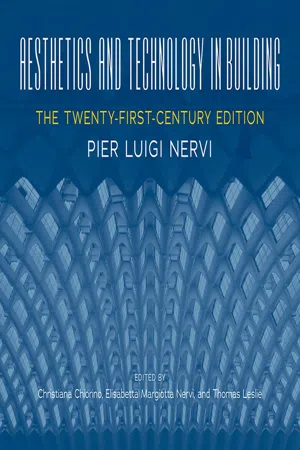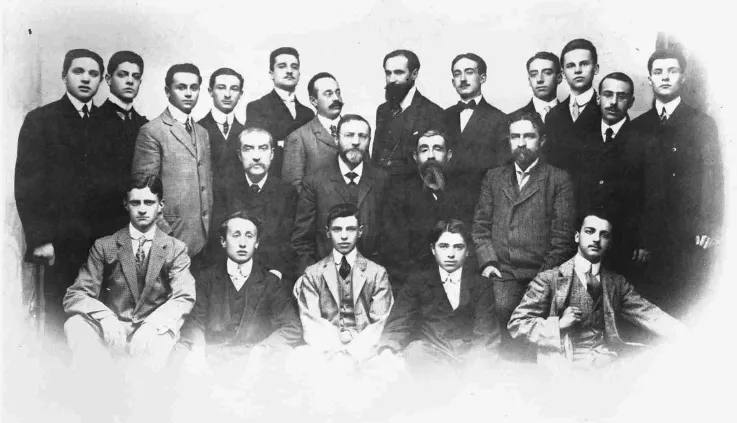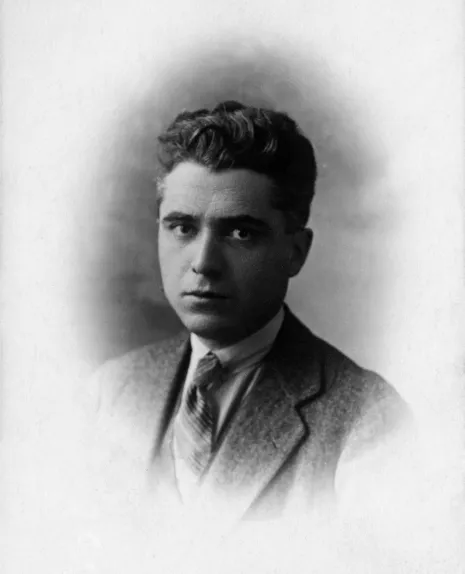![]()
CHAPTER 1
Pier Luigi Nervi (1891–1979)
GABRIELE NERI
PIER LUIGI IGNAZIO ALBERTO FELICE NERVI was born on June 21, 1891, in Sondrio to Antonio Nervi and Luisa Bartoli. Employed by the Italian Postal Service, Antonio's work took the family (originally from Liguria) to various Italian cities: a young Pier Luigi completed high school in Ancona in 1908 and, pursuing his interests in mechanics and aeronautics, decided to join the military academy in Turin, though he was refused entry after failing his medical exam. Nervi enrolled at the University of Bologna in a two-year course offered by the Faculty of Mathematics, Physics, and Natural Science, home to such professors as mathematician Salvatore Pincherle (1853–1936), mathematician and philosopher Federigo Enriques (1871–1946), and chemist Giacomo Ciamician (1857–1922). At the end of the two-year period, he enrolled in the three-year course at the Scuola di Applicazione per Ingegneri, obtaining his diploma in civil engineering on July 28, 1913.
This was the period of the progressive spread of reinforced concrete in Italy, and its methods of use were the focus of theoreticians and builders, often with very different approaches, who sought to identify a set of convincing rules for a material with such immense potential, but with a hybrid materiality difficult to schematize, and vastly different from its traditional counterparts. Nervi was a university student at the time of the construction of the Ponte del Risorgimento bridging the Tiber River in Rome, a long, low, single-span arch (100 meters in length with a 10-meter rise) that would soon become the object of a heated and emblematic debate. Developed by François Hennebique (1842–1921), the design was the object of much criticism by many scholars who did not share the Frenchman's almost banal, though extraordinarily effective, approach to structural analysis, demonstrated precisely by the stability of the Roman bridge. As a young student Nervi was introduced to this debate by his professor Silvio Canevazzi (1852–1918), one of the first in Italy to hold conferences and lectures on reinforced concrete. Canevazzi was known as a “man of heightened intelligence and one of the few theoreticians capable of evaluating the limits and profound significance of his own theories.”1 Nervi would use this event as an example of the limits of theory when faced with practical evidence, and the need to explore new horizons of design through incessant experimentation.
FIG. 1. Pier Luigi Nervi (first row, second from right) at the Scuola di Applicazione per Ingegneri, University of Bologna, ca. 1913.
Besides Canevazzi, another professor played a determinant role in the early years and direction of Nervi's career: Attilio Muggia (1861–1936), an engineer and architect highly active in Bologna during this period. He would become Nervi's first employer—after graduating, the young student went to work for Muggia's company, the Società Anonima per Costruzioni Cementizie (SACC)—but above all he represented a professional model to which Nervi aspired. Muggia was particularly active as a professor, theoretician, designer, and entrepreneur (he was one of the few concessionaires of Hennebique's patent in Italy): a range of roles and competences that Nervi would himself assume with success and conviction during the following decades.
In November 1914, graduated and working for the SACC, Nervi enrolled at the Faculty of Jurisprudence at the University of Bologna, though he never completed a single exam. Following the outbreak of World War I, Italy soon found itself embroiled in the global conflict: in 1915 the young Nervi was drafted to the Civil Engineering Corps and sent to the front, where he would remain for only a few months due to an attack of typhus. In March 1916, after a period of convalescence, Nervi was assigned to a battalion of blimps, which offered him the possibility to develop diverse patents and studies and to demonstrate his propensity for technique and an empirical approach, fundamental to the development of his future inventions in the construction industry.
In 1919, after being discharged, Nervi returned to work for Muggia's SACC in Florence. He had now acquired a broad autonomy in managing projects. He was involved in designing the structures for the Pelota playing hall in Florence (1919–21), bridges over the rivers Cecina (1920–23) and Pescia (1922–23), and various civil works (parking structures, cisterns, and the like), together with a significant number of patents. Away from job sites Nervi also began to develop a network of important public relations—first and foremost among professional associations—that would prove fundamental to his work as an entrepreneur and designer. In 1921 he was nominated secretary of the new board of directors of the Florence section of the National Association of Engineers. Nervi's commitment toward his fellow professionals intensified between 1922 and the following year, at a delicate time for Italy. October 28, 1922, saw the March on Rome that would lead King Vittorio Emanuele III to entrust Benito Mussolini with the formation of a new government. In the wake of reforms introduced by the government in the months that followed—very attentive toward professional corporations—Nervi contributed to the birth of the Florence section of the Sindacato Nazionale degli Ingegneri (National Union of Engineers), tied to the Confederazione Fascista (Confederation of Fascists), of which he was elected president in 1923. The ties between professional and political categories were the subject of intense reflection by the young engineer, who spoke at length with friends and colleagues, torn between autonomy and a more restrictive bond with fascism. Despite his many doubts, Nervi saw adhesion to the fascist union as a means for obtaining a greater social importance for his category, reflecting the position of many other professionals and intellectuals at the time and permeated by a cautious trust in the reformist potentialities of fascism. Political interference was offset by a fundamental objective, to which Nervi held fast for his entire career: the recognition of the ethical and practical value of the role of the engineer in society.
FIG. 2. Pier Luigi Nervi, ca. 1922.
FIG. 3. Company brochure, Ing. Nervi & Nebbiosi, 1920s.
A particularly significant moment came in the summer of 1922 with the publication of a letter Nervi wrote to the director of Ingegneria, a monthly technical journal published by the National Association of Italian Engineers. Leaving aside a few previous contributions, this letter was the first sign of Nervi's intense activity as a writer, an activity that would clarify his building inventions and above all his philosophy of construction, in various books and hundreds of articles and essays published in the most important Italian and foreign journals. This theoretical dimension, inseparable from professional practice and the construction site, brought Nervi closer to other famous engineers of his time, such as Auguste Perret (1874–1954), Eduardo Torroja (1899–1961), Arturo Danusso (1880–1968), Félix Candela (1910–1997), and Ove Arup (1895–1988).
The year 1923 was a turning point in Nervi's professional career. Differences of opinion with Attilio Muggia caused Nervi to leave the SACC to open his own practice, founding a new company together with the Roman businessman Rodolfo Nebbiosi: “Ing. Nervi & Nebbiosi.” This marked the beginning of a new phase for Nervi, accompanied by some of the most important events in his personal life: on April 27, 1924, he married Irene Calosi, who would remain by his side throughout his life and with whom he would have four sons. The eldest, Antonio, was born the next year, followed by Mario, Vittorio, and Carlo. The Nervi family moved to Rome where a few years later he erected a building designed by Giuseppe Capponi (1893–1936) on the Lungotevere Arnaldo da Brescia, near Piazza del Popolo, that would become his home and office for the next decades. Rome thus became his base of operations, where he directed his projects around the globe and honed his new methods of construction.
With branches in Rome, Florence, and Naples, “Ing. Nervi & Nebbiosi” designed and built such structures as the Banchini Theatre in Prato (1923–25) and the Augusteo cinema-theater in Naples (1924–29), a large performance space for twenty-five hundred spectators. Despite their complexity and elegance, Nervi's structures remained concealed from view beneath dense stylistic decorations, demonstrating a contradiction inherent to the architecture of this era, which was not yet ready to accept the exposure of the new formal and structural horizons made possible by a new material. This paradox was typical of reinforced concrete constructions from the early twentieth century: the novelty of this building technique, which allowed for longer spans, large openings, and an unprecedented freedom in plan, clashed with the reiteration of historic styles that, above all in public buildings, entirely masked a building's structure. Nervi would later comment on these contradictions on many occasions: “When I studied at the esteemed Faculty of Civil Engineering in Bologna, the word ‘architecture’ referred essentially to the study of façades and their details. Neither our professors, nor we ourselves, ever considered that a bridge, a load bearing structure, an urban plan could participate in creating, or actually be, a work of architecture.”2
Everything changed with the Giovanni Berta Stadium in Florence, designed and constructed by Nervi and his company (in 1932 Nervi closed Nervi & Nebbiosi and founded the Società Ingg. Nervi & Bartoli with his cousin), beginning in 1930. The typology of this project, which aspired above all to functional and economic objectives, permitted Nervi to expose the extraordinary reinforced concrete structures he conceived, demonstrating their audacity and plasticity. Calibrating costs and functional requirements, Nervi managed to give a frank and modern appearance to the various elements that made up the building: the slender canopy over the grandstand seating; the famous heliocoidal stairs similar to a sculpture in reinforced concrete; the tapered Maratona tower clad in glass and some 55 meters high. The Berta Stadium had a profound impact on critics: in this work of engineering many saw the evolution of modern architecture in Italy during a strong celebration of the aesthetic potentialities of technology and its high priests: engineers. Besides, this was the time when Italy—following the example set by other countries—was fighting the battle in favor of modern architecture: these were the years of the Santa Maria Novella Station in Florence by Giovanni Michelucci (1891–1990), the debut of Giuseppe Terragni (1904–1943) and the Gruppo 7, and of the editorial and architectural battles fought by Edoardo Persico (1900–1936) and Giuseppe Pagano (1896–1945).
Nervi's most precocious and enthusiastic admirer was critic Pietro Maria Bardi (1900–1999), who made a powerful contribution to the celebration of the role of engineering in the process of building modern architecture in Italy. For Bardi, engineers were “architects coherent with the times,” as they “create beginning from purely functional concepts—logic, technique—often arriving, through technology, at aesthetic results.”3 In an article published in the Milanese daily paper L'Ambrosiano, he wrote about “the monumental beauty of the completely functional and intentionally architectural construction stripped of any decorative element and veined solely by its essential structural lines. The Florence stadium constitutes a clear example of contemporary architecture […and] these […] are the monuments of fascist Italy: certainly not the false Roman arches.”4 In April 1933, in Casabella magazine, Giulio Carlo Argan (1909–1992) and Giuseppe Pagano, together with Bardi, dedicated numerous words and photographs to Nervi's work, transforming it into an icon of its era, even overseas. The popular success of the Berta Stadium thus marked Nervi's triumphal entrance into the world of architecture, a world of journals, public debates, and exhibitions, and it afforded a much greater visibility than the world of engineering. Nervi the engineer was soon referred to as an architect—for example, by Bardi, who in 1933 referred to him as “one of our liveliest architects, on the front lines of the advance led by the younger generations to affirm a spirit and a corresponding reality, contemporary and entirely new.”5
If the professional commitments of the 1920s slowed Nervi's theoretical production, in 1931 he published an article in which he outlined one of the fundamental theses of his philosophy of construction, which he would expand on in successive years. In “Scienza o arte dell'ingegnere?” Nervi refuted the pretext of exactness and objectivity inherent to the mathematical approach generally employed in structural design. Instead, he demonstrated the inevitable approximation (in other words, noncorrespondence) between theory and the reality of physical phenomena. The structural enigmas Nervi observed—as demonstrated by the example of Ponte del Risorgimento—presented too many unknowns and variables to be summarized in a nonlimiting theoretical structure. According to Nervi, “those numbers reached using formulas that treat inexact things with exactness” can be considered only as guiding parameters, to be interpreted and evaluated by sentiment and intuition, “the only faculties capable of evaluating that which cannot be evaluated using a ruler and scale.”6 This is a very powerful thesis, often misinterpreted by engineers as a concession to subjective experience's judgment and by architects as the rejection of science in favor of greater artistic freedom. In reality Nervi always considered the two terms—art and science—as inseparable components of the design process, to be synthesized and translated into structural form based on practical experience acquired onsite.
Other articles Nervi wrote on theory, worthy of note from this period, he penned for Casabella and Quadrante. There was also a sporadic though significant collaboration with Architettura, the review of the Sindacato Nazionale Fascista Architetti (National Union of Fascist Architects), directed by Marcello Piacentini. These press appearances were complemented by a host of exhibitio...



